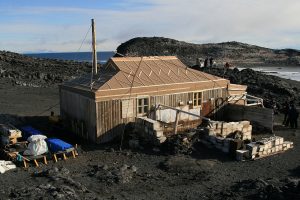In the late nineteenth and early twentieth centuries, 17 expeditions were launched by 10 different countries to explore Antarctica. Ernest Shackleton and other adventurers traveled to the largely unexplored frozen continent to advance cartography, oceanography, and meteorology, as well as to seek the glory of being the first explorers to reach the south pole. In addition to the many scientific advances of these expeditions, they also left another legacy: wood buildings created for shelter, in an otherwise woodless environment. Now, a recent article in Scientific American talks about how scientists are finding fungi growing on these century-old wood structures.
Fungi have been crucial for the development of modern medicine. In addition to being the basis for penicillin, they are also critical for the immunosuppressant cyclosporine and the cholesterol drug lovastatin. With the ever-increasing threat of antibiotic-resistant pathogens, scientists are always on the lookout for new antimicrobial compounds.
Scientists at the University of Minnesota took samples of the fungi found growing on the Antarctic wood and ran it through a battery of tests looking for new compounds. They ended up finding nine compounds previously described by science. However, when run through various pharmacology and toxicology panels, none of them were effective at killing any of the tested human pathogens or the two types of mammalian cancer cells tested.
Even though this initial result proves disappointing, the researchers continued to study the chemicals created by the fungi. One specific compound, colomitide C, was produced by these fungi in vastly larger amounts compared to related fungi and bacteria: their production levels were over 1,000 times what would be expected. The same scientists have pushed on to explore to colomitide C in several experiments. In one study, they looked at how colomitide C interacted with growing tissue in zebrafish. They found that the compound halted the growth of rapidly-growing tissue, implying that there is potential for colomitide C as a method to inhibit the growth of certain cancerous tumors. Another study found that colomitide C could reverse the development of breast cancer cells in mice, although those results are still in the process of being replicated.
Our refrigerated incubators are well suited for zebrafish research. These chambers have a temperature range of 2-50°C. The chambers are very versatile and can be adapted to create environments requiring vibration resistance, complete darkness, intense lighting, or a combination of variables. A microprocessor controls and displays the chamber temperature, and high and low temperature mechanical failsafes protect chamber contents in the unlikely event of a temperature excursion. For the lighting in our chambers, we use cool white (4100K color) LED lights. Coincidentally, the light from these LEDs is most intense in the blue spectrum that is favorable for zebrafish rearing.
For experiments involving mice or other rodents, Powers Scientific offers rodent chambers that are adaptable to a variety of environments. Our chambers offer a temperature and lighting controlled environment with a temperature range of 6.5-50°C, and 0-15 fresh air exchanges per hour. Each chamber comes equipped with features such as clock-controlled lighting, solid doors, an interior outlet and access port, doors locks, an audible/visual alarm with relay, stainless steel construction, and casters. Many other options are available, including additional lighting or LED lighting, dual or multi-point temperature control for temperature stressing, top-mounted or remote compressors, extra-deep sizes, or RS-232 or data retransmit outputs. Our chambers are all built to order, allowing the individual researcher to tailor the incubator to fit the required parameters of the experiment without paying for features that aren’t needed.
For more information on our refrigerated incubators or rodent incubators, see our product pages or contact us to request a catalog or quote.


